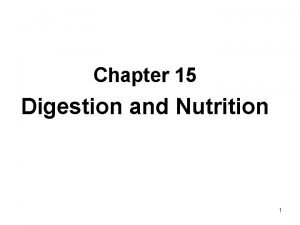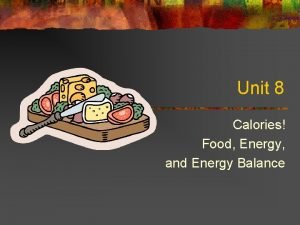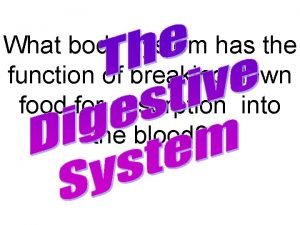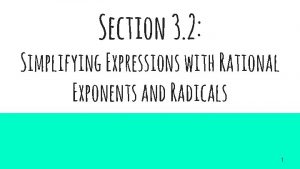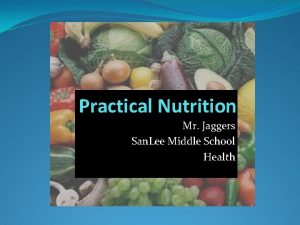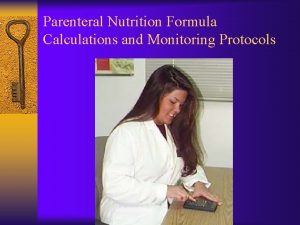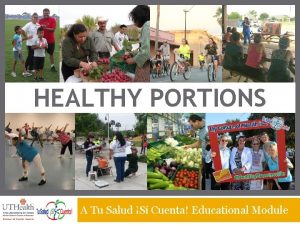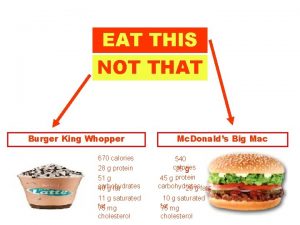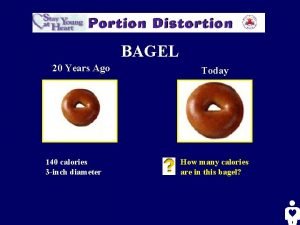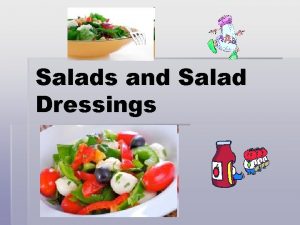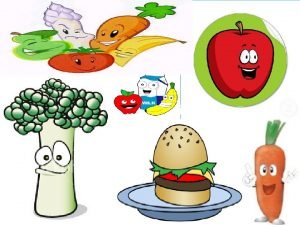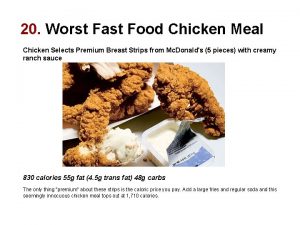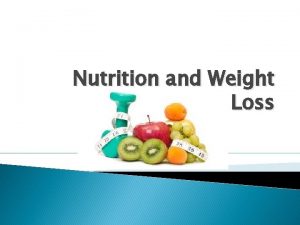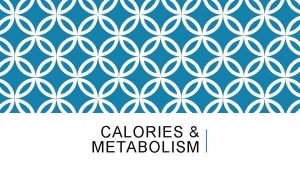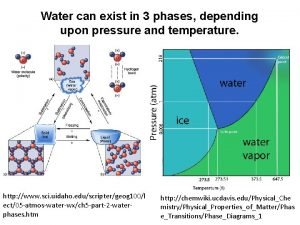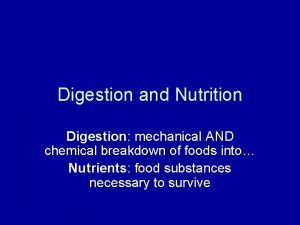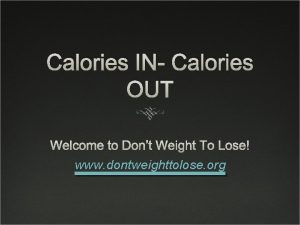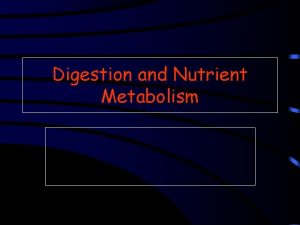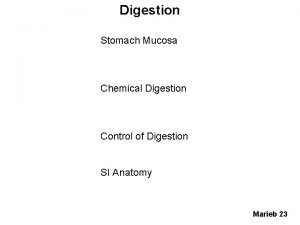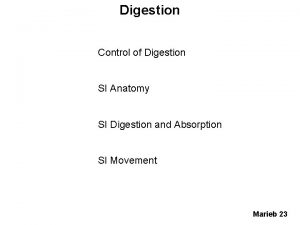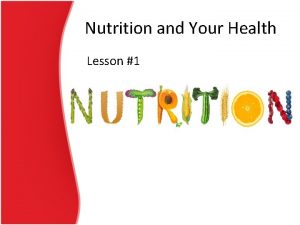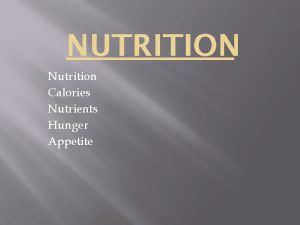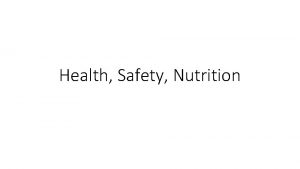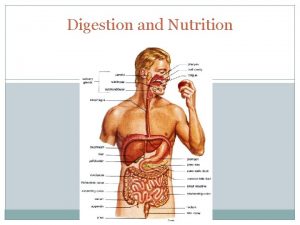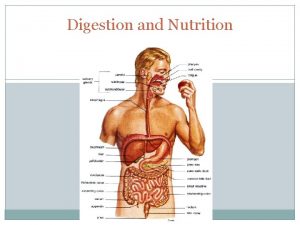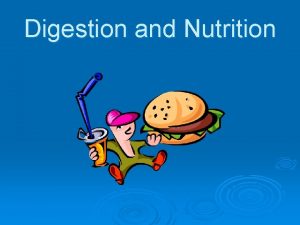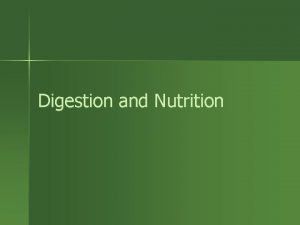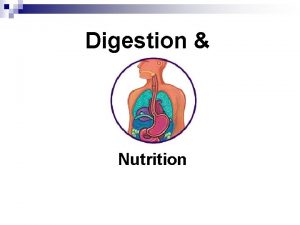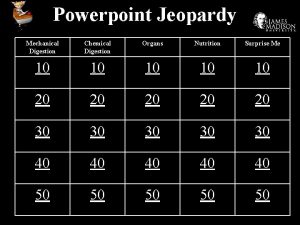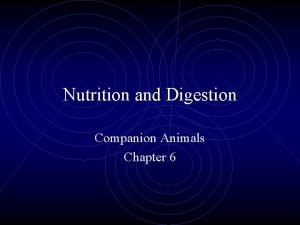Nutrition and Digestion Chapter 38 Calories are the



















- Slides: 19

Nutrition and Digestion Chapter 38

� Calories are the amount of energy that a food contains. ◦ These calories determine how much ATP can be produced by cellular respiration ◦ Different macromolecules can produce different quantities of energy � Carbohydrates = 4 calories/gram � Lipids (Fatty acids) = 9 calories/gram � Protein = 4 calories/gram � Alcohol = 7 calories/gram � The problem is, not all calories are equal! ◦ A person who eats 2, 000 calories worth of energy from high-saturated fat sources (such as ice cream) will be much less healthy than a person who eats 2, 000 calories worth of energy from fruits, veggies, and whole-grains in a balanced diet

So what are “nutrients”? � Nutrients are natural molecules in food that are used for: ◦ Energy production ◦ Growth and tissue repair ◦ Maintenance of homeostasis

� Nutrients amounts: 6 Nutrient Groups come in 6 groups with recommended 1. Water – 64 oz/day! (8 cups) 2. Carbohydrates – <300 g/day, 25 grams of which should be fiber, added sugar should be minimal 3. Protein – 70+ g/day, must include essential amino acids 4. Fats - <10 g Saturated FA/day, 0 g Trans-fats, <90 g/day Total fat 5. Vitamins – used as “cofactors” for reactions, each vitamin has a different recommended dietary allowance 1. Some are fats, most are protein-based 6. Minerals – used as “cofactors” for reactions, each mineral has a different recommended dietary allowance

Nutrients! Tell me more about nutrients! Certain nutrients are called essential nutrients. This means the body cannot produce these molecules from scratch, therefore they must be consumed in the diet. People who do not get enough of these, often find that they become sick easily and feel “run down”

Vitamins are cofactors for chemical reactions. Some are “fatsoluble” and can be stored in the body tissues. Others are “water-soluble” and are excreted in urine A few major Vitamins

A few major Minerals These minerals are not digested by the body. They are lost in sweat, urine, and other waste products and must be replaced with diet

Nutrition Labels � Based on a 2000 cal/day diet ◦ Most people require less! � 45 -65% energy from carbohydrates � 20 -35% energy from fats � 10 -35% energy from protein � So how do we figure out what to eat? Learn to read the labels!

Mypyramid. gov � Choosemyplate. gov offers personalized tools and information to help each person reach their health goals ◦ http: //www. choosemyplate. gov/food-groups/ � The following link is for teenage girls ◦ http: //www. choosemyplate. gov/foodgroups/downloads/Ten. Tip s/DGTipsheet 36 Eat. Smart. A nd. Be. Active. As. You. Grow. pdf Available on the Site: 1. Meal planning 2. Calorie consumption 3. Exercise information 4. Food info for specific ages and activity levels 5. Personal health tracker

Why eat fruits and veggies? Fruits and veggies provide more than just fiber and sugar! They are the richest source of vitamins and minerals out of the food groups. They also contain a wide array of antioxidants which help neutralize cancer-causing chemicals produced by your cells.

Why eat fiber and whole grains? Whole-grains are less processed. As a result, they have all of their natural nutrients in tact. Grains that are “refined” have the husk and germ layer removed. This essentially removes ALL of the nutrients from the grain, except for starch. Manufacturers “enrich” grains by adding back some of the nutrients they remove, but it’s never nearly enough! Fiber keeps your system running smoothly! Helps prevent colon cancers, reduces absorption of “bad” fats, makes you feel fuller for longer, and keeps your blood sugar steady so you don’t feel that energy crash!

Why eat dairy? Dairy is excellent because it contains many “hard to find” nutrients such as some B vitamins, zinc, potassium, calcium and many more! It’s easy to digest (unless you’re lactose intolerant) and high in protein. Protein calories are used primarily for tissue repain and maintenance, therefore, they do not get stored as fat very quickly.

Why eat meat and beans? Beans and legumes are considered meat alternatives. They are full of proteins and many similar nutrients, including iron! They also have TONS of fiber (which meat does NOT have) AND they provide additional minerals that are sometimes hard to get into the diet. Lean meats provide minerals such as iron, potassium, Vitamin D in fish, along with a TON of protein! Make sure to limit red meat though since it tends to have too much saturated fat.

Digestion Basics � Digestion is the process of breaking food down into usable materials ◦ Materials that are small enough to diffuse from the gut (intestines) into the blood in the surrounding capillaries � Two types of digestion ◦ Mechanical: physically tearing or breaking food apart ◦ Chemical: Using digestive juices to break down food �EX: Saliva, stomach acid, pancreatic juices etc.

Primary Organs � Mouth: ◦ Digestion = Chemical (Saliva breaks down carbs) & Mechanical (Chewing, aka: Mastication) � Esophagus: ◦ Tube connecting mouth to stomach, located behind trachea ◦ Peristalsis = wave-like contraction that pushes food to stomach � Stomach: ◦ Digestion = Chemical (HCl and Pepsin breaks down protein) & Mechanical (Stomach squishes and squeezes food to break it down and mix it with gastric juices…turns the food into chyme)

Primary Organs Continued � Small Intestines: � Large Intestines: ◦ Digestion = Chemical (Enzymes and digestive fluids released from accessory organs finish the digestion) ◦ Almost ALL digestion takes place here ◦ Water reabsorption also occurs here ◦ ALL absorption of nutrients takes place here! ◦ No digestion ◦ Final adjustment of water concentration �Too much water in feces = diarrhea �Too little water in feces = constipation ◦ Lots of bacteria live in the large intestines, these help with the production of necessary vitamins and molecules the body needs � Rectum: ◦ Small, straight segment at the end of the large intestines � Anus: ◦ A pair of Sphincter muscles that control bowel movements

Accessory Organs � The Liver: ◦ Produces bile which is a necessary substance for fat digestion and transportation through the intestines and blood ◦ Bile is stored in the gall bladder between meals � Pancreas: ◦ Sits behind the stomach ◦ Produces a ton of enzymes involved in digesting proteins, fats and the rest of carbs � Both organs release their digestive fluids directly into the beginning section of the small intestines

Specialized Structure of the Small � The lining of the intestine Intestines is super-highly folded to increase surface area ◦ This creates more area for nutrients to be absorbed � The folds are called “villi” � Each villi is covered in thousands of microscopic finger-like projections called “microvilli” ◦ These create even more surface area � Each villi has a tiny capillary network inside for the absorption of nutrients

What next? � Food in the small intestines is digested by enzymes and mixed as it moves along ◦ Amino acids, monosaccharides, fatty acids and cholesterols are absorbed by the microvilli, through the epithelial cells and into the capillaries of each villi ◦ The undigested material and what ever is not absorbed, continues to move through the small intestines into the large intestine. � The excess water is removed from the food as it passes through the large intestines (takes about 12 to 24 hours!!) ◦ The leftover material at the end is officially called “feces” ◦ As the feces stimulates nerve receptors in the rectum, a signal is sent to the brain that it is time to defecate ◦ You know what happens next….
 Insidan region jh
Insidan region jh Chapter 15 digestion and nutrition
Chapter 15 digestion and nutrition Biobeyond unit 8 counting calories
Biobeyond unit 8 counting calories Saltine cracker digestion lab
Saltine cracker digestion lab Burning calories part/gland and the effect
Burning calories part/gland and the effect A particular panda consumes 1944 calories
A particular panda consumes 1944 calories Jaggers calories
Jaggers calories Tpn calculation example
Tpn calculation example Portion of pasta calories
Portion of pasta calories Cinnabon classic roll calories
Cinnabon classic roll calories How many calories are in today's bagel
How many calories are in today's bagel Amoebas
Amoebas Aidan laing
Aidan laing I grow strong by eating
I grow strong by eating Calories bretzel ancel
Calories bretzel ancel 3 chicken selects calories
3 chicken selects calories Calories
Calories Haribo c'est beau la vie
Haribo c'est beau la vie What are calories? *
What are calories? * Rain shadow
Rain shadow

